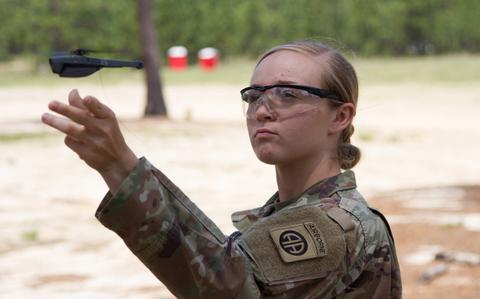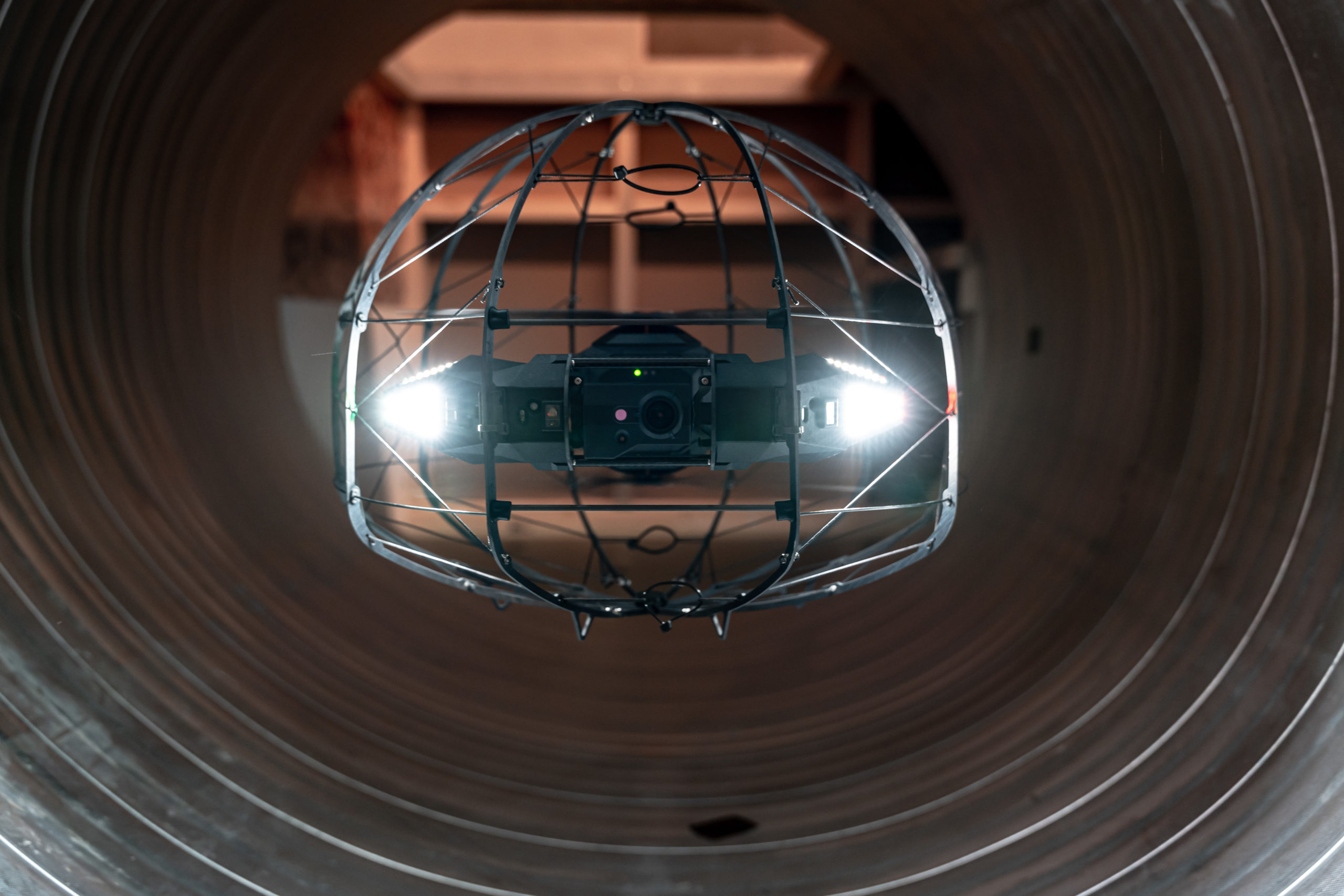https://spectrum.ieee.org/automaton...op-showcase-bioinspired-underwater-propulsionMost underwater robots use one of two ways of getting around. Way one is with propellers, and way two is with fins. But animals have shown us that there are many more kinds of underwater locomotion, potentially offering unique benefits to robots. We’ll take a look at two papers from ICRA this year that showed bioinspired underwater robots moving in creative new ways: A jet-powered squid robot that can leap out of the water, plus a robotic scallop that moves just like the real thing.
This “squid-like aquatic-aerial vehicle” from Beihang University in China is modeled after flying squids. Real squids, in addition to being tasty, propel themselves using water jets, and these jets are powerful enough that some squids can not only jump out of the water, but actually achieve controlled flight for a brief period by continuing to jet while in the air. The flight phase is extended through the use of fins as arms and wings to generate a little bit of lift. Real squids use this multimodal propulsion to escape predators, and it’s also much faster—a squid can double its normal swimming speed while in the air, flying at up to 50 body lengths per second.
The squid robot is powered primarily by compressed air, which it stores in a cylinder in its nose (do squids have noses?). The fins and arms are controlled by pneumatic actuators. When the robot wants to move through the water, it opens a value to release a modest amount of compressed air; releasing the air all at once generates enough thrust to fire the robot squid completely out of the water.
Install the app
How to install the app on iOS
Follow along with the video below to see how to install our site as a web app on your home screen.
Note: This feature may not be available in some browsers.
You are using an out of date browser. It may not display this or other websites correctly.
You should upgrade or use an alternative browser.
You should upgrade or use an alternative browser.
UAV / UCAV / LAR (robotit) Uutiset ja jutut
- Viestiketjun aloittaja Raveni
- Aloitus PVM
https://yle.fi/uutiset/3-10851402Vuoden kuluttua droonin lennättämisestä tulee laitonta ilman verkkokurssin ja -tentin suorittamista. Tähän asti droonilla lentämiseen on voinut hankkia oppia esimerkiksi alan vanhempien harrastajien roottorien suojissa. Näin teki myös drooni-ilmailua harrastava Marko Saikkonen.
– Minulla oli matkan varrella kaksi tuutoria, joilta sain alkutuntumaa ja vihjeitä, miten droonia kannattaa lennättää ja millä tavalla se on turvallista.
– Ohjeistuksessa korostui turvallisuus. Muun ilmaliikenteen huomioiminen, etäisyydet lentokenttiin ja muihin kohteisiin ja millä korkeudella ylipäätään on lupa lentää.
Suomessa droonien harrastajamäärät ovat kasvaneet viime vuosien aikana. Tarkkaa lukumäärää on vaikea arvioida, mutta liikenne- ja viestintävirasto Traficomin asiantuntijan Jukka Hannolan mukaan saatetaan puhua jopa 100 000 harrastajasta.
Mechatronics Lab Kyoto University - Mechatronics lab Graduate School of Engineering
当研究室での研究の四本柱は制御,生物模倣,レスキュー,インタフェースです. これらはすべてお互いに密接に関係していると共に,何らかの意味で人間とも深く関っています.当研究室ではメカトロニクス技術をベースに,人間の本質的理解と人間に役立つ機械システムの実現を目指しています. 教育・研究の方針は,学生個々の自主性を重んじ,テーマ着想,理論展開,システム開発,実験,学会発表等を通じて,研究の醍醐味を味わってもらうことです.メカトロニクスという分野の特性上 機械工学だけでなく,制御,電気・電子回路,プログラミングなど多岐にわたる知識が必要に迫られ,結果的に身につくことでしょう.
www.mechatronics.me.kyoto-u.ac.jp
Testing Agile Cargo Drone Delivery to Improve Healthcare in the…
Hard-to-reach communities need more than paved roads to access healthcare. They need both affordable and convenient transportation to and from local…
FLIR:n minidroneja lähtee Afghanistaniin sinne rotaatiossa lähtevän porukan mukana.
First Army battalion with mini drones heading to Afghanistan


 www.stripes.com
www.stripes.com
Edit: https://www.flir.eu/products/black-hornet-prs/
First Army battalion with mini drones heading to Afghanistan

KABUL, Afghanistan — Soldiers with the 82nd Airborne Division will be the first infantry Army battalion to employ pocket-sized drones at the squad level on their upcoming Afghanistan deployment.
Troops with the Division’s 3rd Brigade Combat team were issued Black Hornet Personal Reconnaissance System this spring and provided training on how to use the drones, which resemble miniature helicopters.
The 1st Battalion, 508th Parachute Infantry Regiment, is planning to employ the machines next month in Afghanistan, while other elements of the brigade wait to see how best to leverage the system, a brigade spokesman told Stars and Stripes.
The hand-held devices are expected to become standard kit for units across the Army, providing near-real time video that will allow soldiers to better survey their surroundings and detect enemies in combat.
“This kind of technology will be a life-saver for us because it takes us out of harm’s way while enhancing our ability to execute whatever combat mission we’re on,” said Sgt. Ryan Subers, who received the training, quoted in an Army statement. “I’m very grateful for technology like this and to be a part of the first unit to use it.”
Pfc. Kyle Dinsmore, 1st Battalion, 505th Parachute Infantry Regiment, 82nd Airborne Division gets his turn to use the system during the SBS fielding at Fort Bragg, N.C., May 2, 2019.
PATRICK FERRARIS/COURTESY U.S. ARMY
The Army initially bought Black Hornets, made by Oregon-based FLIR Systems Inc., for testing with Special Forces units in 2016. The devices are extremely light, nearly silent and have a flight time of up to 25 minutes, the company’s website said.
At a demonstration in Norway during a NATO exercise last fall, a FLIR official said the drone, which weighs less than two ounces, can be deployed in less than one minute and has a range of over a mile. It’s intended to eliminate battlefield blind spots with the aim of saving troop’s lives and avoiding unintentional damage or deaths.
“With this system, you can [positively identify] enemies, you can look for [improvised explosive devices] on your route,” said Kristian Molander, a FLIR supervisor and operator, in a video interview. “If you’re taking fire from areas you can’t see, you can use this system to identify stuff before you move into the line of fire.”
Teaching a soldier to fly it takes two minutes, Molander said. Training an instructor takes less than three days.
Wireless commands and data sent between the drone and its controller are encrypted to protect it against hacking, the Army said in a statement last May in which the service said it had ordered about 60 systems.
In addition to a $2.6 million contract awarded to FLIR last spring, the Army awarded the company nearly $40 million in January of this year to provide Black Hornets for the Army’s Soldier Borne Sensor program. The deal would provide the Army with 9,000 systems, each with two drones, Breaking Defense reported this month. However, FLIR was unable to confirm to Stars and Stripes the number of devices to be delivered.
The basic configuration of a Black Hornet system includes one drone for day and one for night, a base station that connects to a handheld controller, and a display about the size of a tablet computer, but it varies from customer to customer, said FLIR spokesman Joe Ailinger Jr. “The configuration is flexible and can be customized as needed,” he said.
Elements of the Fort Bragg, N.C.-based 3rd Brigade Combat Team, including the drone-equipped battalion, will be deploying to Kandahar in southern Afghanistan next month, a brigade spokesman said. They will replace the 2nd Brigade Combat Team, 10th Mountain Division, out of Fort Drum, N.Y, which deployed to the country last fall to support the dual U.S. mission — a bilateral counterterrorism effort with the Afghans and a NATO-led effort to build up and support the Afghan security forces.
The 1st Security Force Assistance Brigade, which was deployed to Afghanistan last year, is set to become the second Army unit to receive Black Hornet drones later this year.
[email protected]
Twitter: @pwwellman


First Army battalion with mini drones heading to Afghanistan
Edit: https://www.flir.eu/products/black-hornet-prs/
Viimeksi muokattu:
BeetleCam turns 10! - Will Burrard-Lucas Blog
This month it is ten years since I finished building the first BeetleCam. At the time, I had no idea how much BeetleCam would go on to shape my career.

HUG
HUG is the haptic user interface for telemanipulating our humanoid robot Justin. With its two light-weight robot arms, HUG can precisely measure the movements conducted by the human operator and at the same time display the forces that occur in the distant environment.

Flybotix - Home
The professional inspection solution - ASIO PRO Our revolutionary drone is designed to help you perform fast, efficient and safe inspections in your industrial assets
Viimeksi muokattu:
BeetleCam = Tiedustelukamera puolustusvoimille. Ei nyt keskelle metsää mutta metsäteille ja asustuskeskuksiin.
Kieltämättä tuollainen olisi helpompi kätkeä kuin esim. tähystyspartio kun halutaan saada ennakkovaroitus vihollisen liikkeistä ilman että vihollisen ilmatiedustelu havaitsee tähystäjät. Toisaalta, aika pitkälle pääsisi jos olisi pelkkä kamera joka jättää tien varteen ja sitten joku vaan istuu läppärin äärellä jossakin suojassa lämpötähystykseltä.
Toisaalta, aika pitkälle pääsisi jos olisi pelkkä kamera joka jättää tien varteen ja sitten joku vaan istuu läppärin äärellä jossakin suojassa lämpötähystykseltä.
Riistakamera. Tällä hetkellä niissä ei ole lähetys toimintoa, mutta tarvittaessa sellaisen saa siihen liitettyä ja jos valvoja tarvitsee laukaista toimenpiteitä niin vastaanotto puoli on helppo järjestää sekin. Ainoa ongelma on että jos tunnistelijan vehkeessä on tunnistimet radioliikenteelle niin se saattaa aiheuttaa hillottamisen. En tiedä haluaako ihmiset kuljettaa kuitua taikka koaksiaalikaapelia mukana jos riistakameroita käytettäisiin valvomiseen.
Beetlecam tuo sen kameran takaisin ja sen voi liikuttaa toiseen paikkaan, on sen etu. Parveilukin onnistuu keinoälyn ja koneoppimisen kanssa. Parvessa yksilö(t) voi liikkua ECM kentän ulkopuolella, vaikka toiset olisivat sen sisäpuolella.
Riistakamera. Tällä hetkellä niissä ei ole lähetys toimintoa, mutta tarvittaessa sellaisen saa siihen liitettyä ja jos valvoja tarvitsee laukaista toimenpiteitä niin vastaanotto puoli on helppo järjestää sekin. Ainoa ongelma on että jos tunnistelijan vehkeessä on tunnistimet radioliikenteelle niin se saattaa aiheuttaa hillottamisen. En tiedä haluaako ihmiset kuljettaa kuitua taikka koaksiaalikaapelia mukana jos riistakameroita käytettäisiin valvomiseen.
Näkisin, että tuon kaapelin kanssa valinta riippuu siitä, kuinka kauas se kuva halutaan lähettää. Jos se halutaan jonnekin komentopaikalle asti, niin silloin tuskin voidaan käyttää kaapelia (vaikka sen tarve periaatteessa lisääntyykin, eihän komentopaikan tulisi säteillä!), mutta 10-50 metrin piuhan pitäisi olla ihan mahdollinen. Luonnollisesti tuossa on varmistettava, että vihollisen jalkamiehet eivät kompastu piuhaan, mutta ainahan tähystäjiltä vaaditaan tietynlaista valppautta muutenkin kuin vain sen heille osoitetun tähystyssuunnan suuntaan.
Designing custom "hybrid drones" | MIT CSAIL


Palladyne AI Corp.
Unleash the power of robotic systems with the Palladyne AI software platform to enable robots to observe, learn, reason, and act like humans.

Meet Aquanaut, the Underwater Transformer
Houston Mechatronics built a robot sub that transforms into a skilled humanoid
 spectrum.ieee.org
spectrum.ieee.org

https://www.armyrecognition.com/arm...the_korsar_advanced_reconnaissance_drone.htmlRussia demonstrated its most advanced Korsar reconnaissance drone at the Army-2019 international military and technical forum for the first time.
As the drone’s accompanying materials indicate, the Korsar belongs to the class of short-range reconnaissance drones. The drone has a maximum takeoff weight of 200 kg and a flight range of 120 km. The Korsar can develop a speed of 120-150 km/h at an altitude of up to 5,100 meters. Its flight duration is 10 hours.
The drone is equipped with a 50 horsepower piston engine. Eventually, it will get a 70 horsepower power unit.
The Army-2019 forum is opening at the Patriot Congress and Exhibition Center outside Moscow on Tuesday and will last through June 30. The forum's events will take place in other Russian regions as well. According to preliminary estimates, the forum on the territory of Russia will be attended by over 1,500 enterprises that will demonstrate more than 27,000 products and technologies.
Suhoj S-70 UAV prototyyppi on lentänyt ensilentonsa.
Koneen suunnittelussa on mahdollisesti hyödynnetty Iraniin pudonnutta RQ-170 Sentineliä, ja mahdollisesti myös Serbian pudottaman F-117 Nighthawkin osia.

 www.thedrive.com
www.thedrive.com
Koneen suunnittelussa on mahdollisesti hyödynnetty Iraniin pudonnutta RQ-170 Sentineliä, ja mahdollisesti myös Serbian pudottaman F-117 Nighthawkin osia.

Full Analysis Of The First Flight Of Russia's 'Hunter' Unmanned Combat Air Vehicle
This is a significant achievement for the program, but serious questions remain about the drone's design and exact capabilities.
https://www.theregister.co.uk/2019/08/13/watchkeeper_drone_crash_wk050_aberporth/A British Army Watchkeeper drone that crashed near its home base of Aberporth in south Wales did so after its crew overrode its autopilot, causing the unmanned aircraft to hit a tree.
The Watchkeeper, tail number WK050, was destroyed in the June 2018 crash, according to the BBC, which obtained a copy of an internal Ministry of Defence report using Freedom of Information laws.
The MoD refused to supply The Register with a copy of the same report.
According to the Beeb, WK050 was set to land at West Wales Airport in Aberporth. Watchkeepers fly semi-autonomously; human operators can select waypoints on a screen or choose certain commands for it to carry out automatically, including landing. There is no Xbox-style stick-and-rudder feature for manual flying.
Watchkeeper is a customised version of an off-the-shelf drone design which is built by Thales, the French defence 'n' aerospace company. Israeli company Elbit's Hermes 450 unmanned aerial vehicle (UAV), upon which the Watchkeeper is based, does have a manual override feature. This was not included on the 54 aircraft ordered by the UK.
When it landed at Aberporth, WK050 "landed long", reported the BBC. This means that instead of touching down at the correct point towards the start of the runway, giving it a nice long distance in which to harmlessly roll to a stop, the drone was further along than it ought to have been – risking it overrunning off the far end, damaging the aircraft.
Thus, the onboard computer followed its programming and "auto-aborted as it approached the end of the runway". The drone throttled up to full power and took off again, ready to fly itself around in a circuit and have another go at landing. Such things are a fact of life in aviation, whether humans or computers are trying to land.
However, WK050's human operators seemingly became confused at this point – and cut the throttle. WK050 "glided over the road" at the end of the runway and "crashed into a tree" around 900 metres beyond the end of the runway.
"Had no action been taken by the crew the AV (aerial vehicle) would have completed its automatic go-around, from which it could have been commanded to conduct a further approach," the report said.
The Watchkeeper programme has been dogged by poor software design and human error since its inception in 2005.
Watchkeeper is flown by Army operators drawn from 47 Regiment Royal Artillery. So far five of the unmanned aeroplanes – nearly 10 per cent of the entire fleet – are known to have crashed, with the MoD doing its best to hush up crashes unless they happen within eye or earshot of humans. Two were destroyed by crashing into the Irish Sea, which was unknown by the public until the news was blabbed by an admiral at a defence trade show a few years ago.
Another was written off after its operators disabled anti-crash software protections. The Watchkeepers' software itself has also come under fire, as was revealed earlier this year.
The crash-dogged Watchkeeper programme is £400m over its original budget of £800m, totalling £1.2bn of public money so far, and has done no operational (warzone) flying other than a token deployment for three weeks in Afghanistan in the early part of this decade.
Einomies1
Respected Leader
Ei ole ihan halpaa tuokaan. Miksihän alkuperäiset eivät kelvanneet?
Falangi
Kenraali
Luultavasti koska poliikot halusivat joint-venturen kautta työpaikkoja britteihin. Artikkelissa tietty mainitaan vain että Thales on ranskalainen firma, mutta mokat lienevät Thales UK:n käsialaa.Ei ole ihan halpaa tuokaan. Miksihän alkuperäiset eivät kelvanneet?
Vanhempi artikkeli.
Watchkeeper drones cost taxpayers £1bn
And were used on combat ops for just two days
However, the Watchkeeper programme is over budget. Then-defence secretary John Reid told Parliament in 2005 that planned spending on the whole project was just £800m. The aircraft are built by French-headquartered defence multinational Thales and maintained by a joint venture with Israel's Elbit Systems, which designed the original Hermes 450 drone that the Watchkeeper was based on. That Leicester-based joint venture is called UAS Tactical Systems Ltd (U-TacS).
https://spectrum.ieee.org/the-human-os/biomedical/devices/drone-vs-ambulance-drone-winsIn Rwanda, drones routinely swoop through the skies, delivering blood products to hospitals. It’s been a medical coup for the drone industry, covered in IEEE Spectrum’s recent feature report.
Now, a team in Iraq and Australia has developed another way to use drones in healthcare—as part of a system that detects when an elderly person has fallen, then delivers first aid.
Described in the journal Sensor, the drone system successfully reached every fake test patient in a busy city in northern Iraq, and arrived 90 to 120 seconds faster than an ambulance.
The drone successfully and safely arrived at each location before the ambulance, with an average time savings of 105 seconds.
https://spectrum.ieee.org/automaton...e-darpa-subterranean-challenge-tunnel-circuitThe first competitive event in the DARPA Subterranean Challenge concluded last week—hopefully you were able to follow along on the livestream, on Twitter, or with some of the articles that we’ve posted about the event. We’ll have plenty more to say about how things went for the SubT teams, but while they take a bit of a (well earned) rest, we can take a look at the winning teams as well as who won DARPA’s special superlative awards for the competition.
Ja voittaja ekalla radalle, linkin alla muita otoksia



